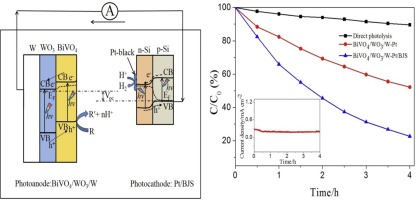当前位置:
X-MOL 学术
›
Appl. Catal. B Environ. Energy
›
论文详情
Our official English website, www.x-mol.net, welcomes your
feedback! (Note: you will need to create a separate account there.)
A highly efficient BiVO4/WO3/W heterojunction photoanode for visible-light responsive dual photoelectrode photocatalytic fuel cell
Applied Catalysis B: Environment and Energy ( IF 20.2 ) Pub Date : 2015-11-11 22:34:17
Ligang Xia, Jing Bai, Jinhua Li, Qingyi Zeng, Xuejin Li, Baoxue Zhou
Applied Catalysis B: Environment and Energy ( IF 20.2 ) Pub Date : 2015-11-11 22:34:17
Ligang Xia, Jing Bai, Jinhua Li, Qingyi Zeng, Xuejin Li, Baoxue Zhou

|
A highly efficient BiVO4/WO3/W heterojunction photoanode was fabricated based on the nanoporous WO3 film, which was prepared on the tungsten plate by anodic oxidation, in order to facilitate the electrons transfer from BiVO4 to WO3 by providing a natural connection between WO3 film and W substrate. Then, a visible-light responsive dual photoelectrode photocatalytic fuel cell (PFC) consisted of BiVO4/WO3/W photoanode and Pt modified commercial buried junction silicon (Pt/BJS) photocathode was constructed. The results showed that the optimized BiVO4/WO3/W photoanode obtained a photocurrent of 2.01mA/cm2 at 0.6V (vs Ag/AgCl) in 0.1M KH2PO4 (pH 7) electrolyte under simulated AM1.5 solar light, which was 180% and 205% higher than that of bare WO3 film and bare BiVO4 film, respectively. The established dual photoelectrode PFC showed high converting performance of organics into electricity. For example, a short-circuit current density of 0.26mAcm−2, which is higher than most of the reported visible-light responsive dual photoelectrode PFC systems, was obtained with the open-circuit voltage of 0.78V and maximum power output of 2.0×10−4 Wcm−2 in 20mgL−1 tetracycline hydrochloride. Furthermore, a removal ratio of 78% after 4h was achieved with a stable output photocurrent in the degradation process.
中文翻译:

用于可见光响应双光电极光催化燃料电池的高效BiVO4 / WO3 / W异质结光电阳极
以纳米多孔WO 3膜为基础,通过阳极氧化在钨板上制备了高效的BiVO 4 / WO 3 / W异质结光电阳极,以通过提供天然电子来促进电子从BiVO 4转移至WO 3。 WO 3膜与W衬底之间的连接。然后,构建了由BiVO 4 / WO 3 / W光电阳极和Pt改性的商用掩埋结硅(Pt / BJS)光电阴极组成的可见光响应双光电极光催化燃料电池(PFC)。结果表明,优化的BiVO 4 / WO 3/ W光电阳极在模拟的AM1.5太阳光下,在0.1M KH 2 PO 4(pH 7)电解液中,在0.6V(vs Ag / AgCl)下在0.6V(vs Ag / AgCl)处获得2.01mA / cm 2的光电流。分别是裸WO 3膜和BiVO 4裸膜。建立的双光电极PFC显示出有机物到电的高转化性能。例如,在开路电压为0.78V,最大输出功率为2.0倍的情况下,获得的短路电流密度为0.26mAcm -2,高于大多数报道的可见光响应双光电极PFC系统。 20 mgL -1中的10 -4 Wcm -2盐酸四环素。此外,在降解过程中,在稳定的输出光电流下,经过4小时后,去除率达到了78%。
更新日期:2015-11-12
中文翻译:

用于可见光响应双光电极光催化燃料电池的高效BiVO4 / WO3 / W异质结光电阳极
以纳米多孔WO 3膜为基础,通过阳极氧化在钨板上制备了高效的BiVO 4 / WO 3 / W异质结光电阳极,以通过提供天然电子来促进电子从BiVO 4转移至WO 3。 WO 3膜与W衬底之间的连接。然后,构建了由BiVO 4 / WO 3 / W光电阳极和Pt改性的商用掩埋结硅(Pt / BJS)光电阴极组成的可见光响应双光电极光催化燃料电池(PFC)。结果表明,优化的BiVO 4 / WO 3/ W光电阳极在模拟的AM1.5太阳光下,在0.1M KH 2 PO 4(pH 7)电解液中,在0.6V(vs Ag / AgCl)下在0.6V(vs Ag / AgCl)处获得2.01mA / cm 2的光电流。分别是裸WO 3膜和BiVO 4裸膜。建立的双光电极PFC显示出有机物到电的高转化性能。例如,在开路电压为0.78V,最大输出功率为2.0倍的情况下,获得的短路电流密度为0.26mAcm -2,高于大多数报道的可见光响应双光电极PFC系统。 20 mgL -1中的10 -4 Wcm -2盐酸四环素。此外,在降解过程中,在稳定的输出光电流下,经过4小时后,去除率达到了78%。

































 京公网安备 11010802027423号
京公网安备 11010802027423号